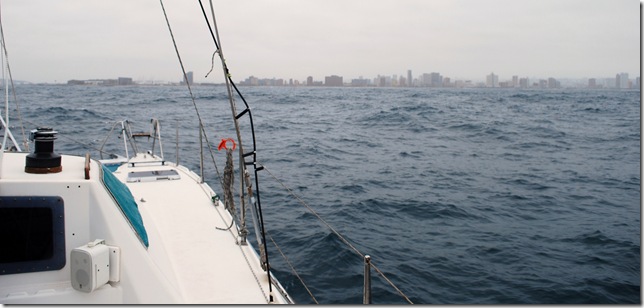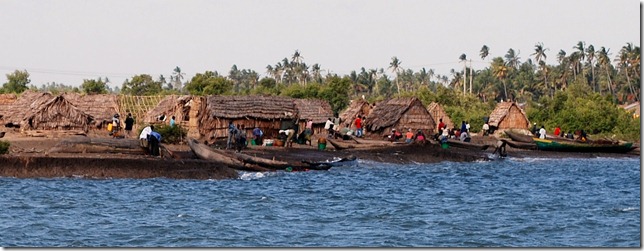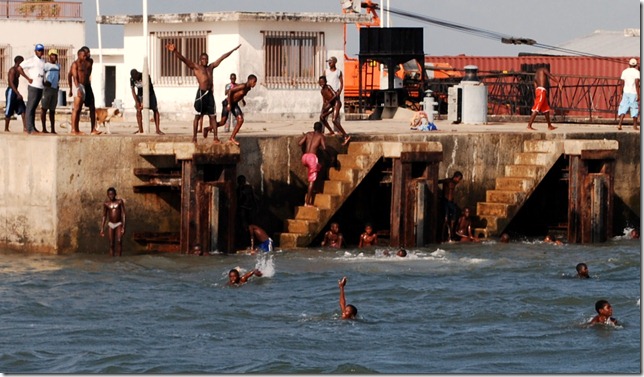Well, I think it’s safe to say that we’re having another “experience”. I guess that’s how Africa is when you visit for the first time. I’m not sure where to start, so I’ll just start at the top.
Durban is the home of South Africa’s largest port, so there was quite a bit of traffic as we approached. Not since we crossed the Panama Canal had we seen so many “super-max” cargo ships loaded to the gills with containers bound for various parts of the world. The way they glided through the oncoming waves, with only the big splashes of water at the bow to show for it, was pretty impressive.
As we approached the harbor, the magnitude of the city quickly became apparent. The beachfront area contains a slew of hotels and looks quite similar to Oceanside Boulevard in Santa Monica where we used to live. Just beyond the beachfront is the downtown area, and many of the colorful art deco-style buildings have a Southern California (or Miami) feel as well. Apparently Durban is the only city in South Africa with this style, as the others have more of a European/colonial or industrial appearance.
We arrived at Durban Marina just before sunset on Saturday and tied up to the international jetty, which is literally across the street from the downtown area. Some friendly South Africans assisted us with the tie up, but they were the first of many to recommend that we remain in the heavily gated and guarded marina area at night. Even during the day, they suggested that we remove all watches (even my $20 Target watch!) and jewelry and try to “look poor”. They summed it up with the three words made famous by the movie Blood Diamond: “This is Africa”. We took their words quite seriously and made our way to the yacht club for dinner rather than attempting to explore.
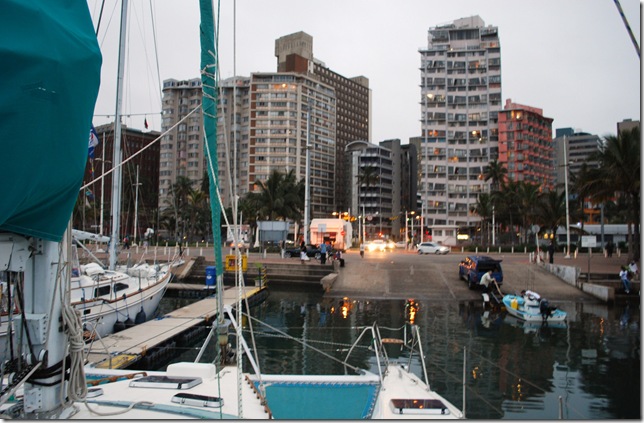 Hard to believe that the urban ghetto is just on the other side of these buildings
Hard to believe that the urban ghetto is just on the other side of these buildings
On Sunday we were getting things in order on the boat when we were visited by Mr. Bob Fraser, a representative of the Point Yacht Club. He invited us up to the bar for a beer and a chat, and it didn’t take too much twisting of our arms for us to follow and agree to sign up for a membership to the club. After a beer, fast-paced conversation, and a closely-matched game of pool, I was very surprised to learn that our companion was 78! He was very knowledgeable about all things political, so there was no shortage of conversation during lunch or the subsequent driving tour of Durban. Having spent several decades as a member of the privileged class, he was by no means an advocate of the apartheid-promoting Afrikaner regime but did not have anything positive to say about the current African government. He confirmed what others had told us about the mass exodus of young whites from South Africa. This is understandable given that the newly passed Black Economic Empowerment legislation requires that businesses work toward becoming 25% owned and 40% staffed by previously disadvantaged racial groups, thus the competition among whites has increased dramatically. He also talked about the high crime rates and cited his personal experience of being mugged, having 3 cars stolen, and having his neighbor survive being burglarized thanks to the fact that he takes sleeping pills and did not wake up! All in all, Bob was a very interesting contact, and he showed us some surprisingly posh areas of Durban that we would not have seen otherwise, all with electric fences, razor wire, and/or security systems.
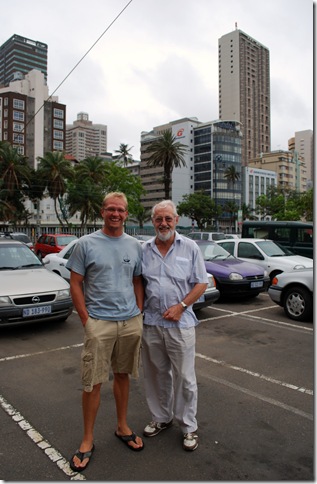 Dallas with the former Commodore of the Yacht Club
Dallas with the former Commodore of the Yacht Club
Monday we ventured out into the city on foot. We walked several blocks over to customs and immigration to clear in, which was a simple, no-hassle affair. We then walked through the center of downtown to do some shopping. We were the only white faces in sight most of the time and later learned that the posh downtown area used to be white-only. Times have certainly changed! Durban is still a very diverse place, though, as it has the largest Indian population outside of India along with lots of immigrants from other African countries. While I didn’t feel unsafe in the city during the daytime, I was definitely on my guard.
When we returned to the marina, we were greeted by Brian and Monica, South African friends of an American friend who have been following the blog recently and drove down from Johannesburg to meet us! They took us to lunch and were very interested in the boat and our trip and shared interesting stories about their own travels. They took us on a drive through the south part of Durban, Brian’s childhood stomping grounds, and it was fun to watch him reminisce. Of course it wasn’t long before the conversation turned to politics, as you can’t get away from it in a country that is in the middle of a political, economic, and cultural upheaval. Brian and Monica both emigrated from the U.K. as children and have a more liberal perspective than the others we have spoken to. Brian spent some time among the Zulu in the mines as a teen and speaks a bit of their language. Being a very gregarious person, he takes advantage of every opportunity to put it to use! His pleasant interactions with Africans and Indians alike fueled my optimism in slowly improving race relations, and his opinion is that many things have in fact improved since apartheid ended.
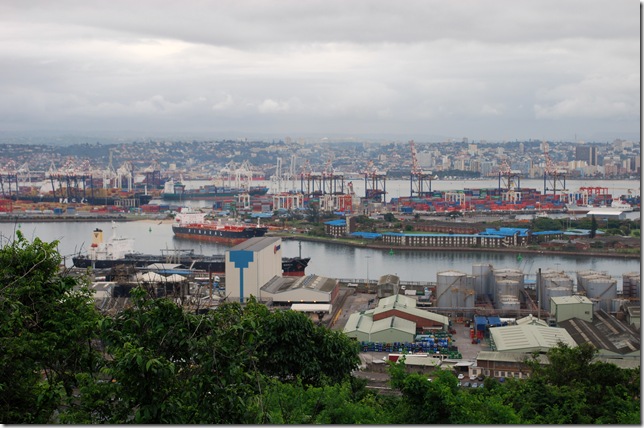 View of the massive harbor from the Bluffs
View of the massive harbor from the Bluffs
It was a pleasure to spend the day with Brian and Monica, and we look forward to seeing them again. There is a good chance that we will take them up on their offer to join them on their return trip to Johannesburg in a couple of days and head up to the Kruger National Park to see the wildlife that Africa is well known for – lions, elephants, rhinos, etc. – in the wild!
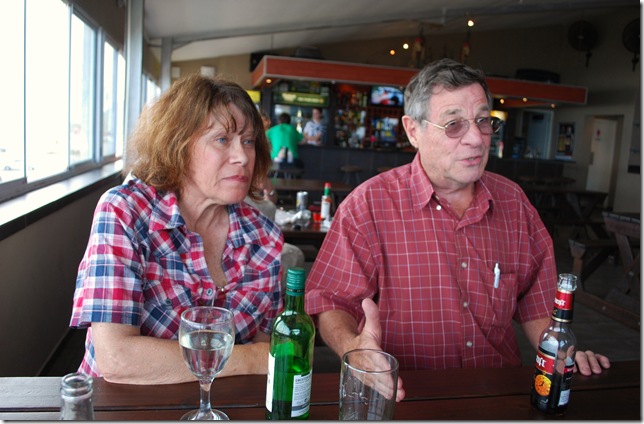 Enjoying an afternoon drink overlooking one of Durban’s beaches
Enjoying an afternoon drink overlooking one of Durban’s beaches
Last night we made some more friends. We were invited to another boat for drinks and met some people involved in the World Atlantic Rally for Cruisers (ARC). The group set sail from St. Lucia in January of this year, and I was surprised to learn that this fleet of boats is rounding the world in 15 months! I thought we were moving fast. Anyway, we befriended a couple about our age that are crewing on a large cat and made some plans to join them for an Indian lunch today at huge Hare Krishna temple in the shape of a lotus flower.
Needless to say, there’s a lot going on here. All of this socializing leaves little time for other things, but Dallas has arranged to have our jib stitched up and to get a quote for new trampolines. We plan to stay in Durban for at least another week before making our way to Capetown via East London, Port Elizabeth, and Krysna.
Lat: 29 25.443′ S
Lon: 31 51.819′ E
While sitting at anchor Thursday afternoon we were hailed by the South African yacht Moondust, whom we’ve never met. They had spotted us anchored north of Inhaca and were also planning to take advantage of the coming weather window to reach South Africa. It was fortunate for us that we made contact with them because we decided to leave together around sunset, which was a bit earlier than I would have left otherwise, but turned out very well for us. We lifted the anchor after enjoying a delicious Thanksgiving shepard’s pie and watching the sunset, then headed offshore behind Moondust.
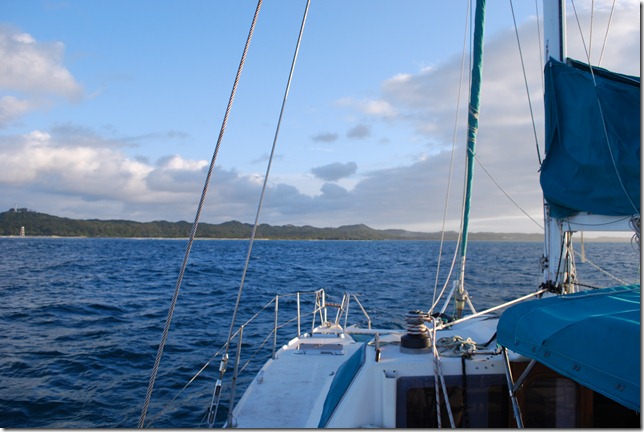 Anchored north of Inhaca in SW breeze after the southerly blew itself out. The lighthouse and leading mark are on the left.
Anchored north of Inhaca in SW breeze after the southerly blew itself out. The lighthouse and leading mark are on the left.
In addition to timing the wind, these short jumps are also about finding the current, which as Moondust agreed, can be a real game of hide and seek, or now you see me now you don’t. We anticipated a counter current between Inhaca and the South African border, and we weren’t disappointed. We made for deep water, hoping the counter current would be less there, and Moondust stayed closer to shore. By heading south initially, they were well ahead of us, but we stayed in contact over VHF through the night and found that the counter current was essentially the same for both of us. There was almost no swell left from the previous day’s blow and we were able to start sailing with easterly winds once we reached deep water and turned south. During the night, however, the wind died as we’d anticipated and we motored until late the next morning when we were able to motorsail and eventually sail without the engine. Moondust was 10 miles ahead and motorsailing 2 knots faster than us, so we eventually lost radio contact with them.
As we reached the South African border and raised the South African courtesy flag, the counter current dwindled and we began to pick up a light favorable current. Both the current and the wind picked up as we headed farther south, making reaching Durban look more like a real possibility. Just in time for our most weather-critical passage to date, the method we’ve been using to download weather information over the sat phone failed. Thankfully, Wes has been forwarding us weather info and we’ve been able to get some additional information from the Peri Peri net, Moondust, and Durban radio. I was initially a bit worried as the timing was looking tight for us to reach Durban before the next round of strong southerly winds, but as evening neared, we started reaching speeds of 8, 9, and even 10 knots. It was just getting dark and Lauren and I both had a spoonful of rice and green curry in our hands when a gust of wind and a large wave made us both look at each other, with Lauren saying “it’s time.” We set down our dinner and went outside to drop the main. As we were finishing up the job, the wind began to blow stronger and with just the jib left up we were still making 7-9 knots.
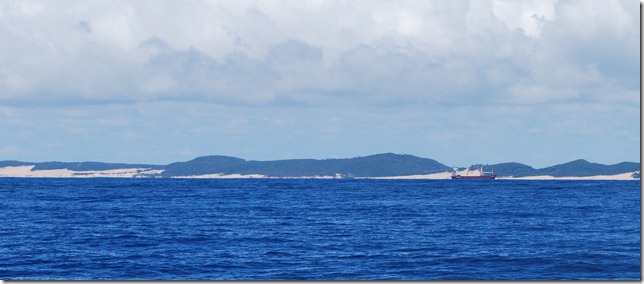 This large vessel is inshore of us and happened to pass by us right at the South Africa – Mozambique border
This large vessel is inshore of us and happened to pass by us right at the South Africa – Mozambique border
Just like on our way to Quelimane, Lauren had the fast watch where we made incredible speeds with perfect winds and a strong current, but this time it wasn’t as uneventful. I’d only been in bed an hour or so when I heard her on the radio trying to hail a ship. They didn’t answer and she called me up to show me that we were on a collision course with a closing speed of 25 knots and a time to impact of 8 minutes. Luckily the AIS/chartplotter has been calculating time to closest proximity incorrectly and we really had close to 30 minutes. I tried radioing them again, and they answered back, confirming that we were visible on their radar, and agreeing to change course. The vessel turned out to be a large cruise ship headed for Maputo, and as they neared us Durban radio came on the air to tell us that Moondust had been trying to get the cruise ship to relay a message to us that like us, they were doing well and had decided to press on for Durban. The fellow manning the radio station was very friendly and we learned from listening to his side of a chat with Moondust that he was in Cape Town, where VHF radio transceivers stationed all along the South African coast are monitored from a central location. You may call Durban or Port Elizabeth radio, and while the tower is local, the voice on the other end will be coming from Cape Town. His office was also a satellite monitoring station where news of our EPIRB/PLB signals going off would be received if we were to activate them in this part of the world.
After a short chat with the radio operator, I headed to bed, and Lauren spent a long final night watch gibing through a thunderstorm with lightning and rain showers. By the time she got me up at 3 am, the winds had died down quite a bit, but we were getting about 4 knots of favorable current to keep us moving at a nice speed. We were already offshore from Richard’s Bay, with the lights of the city and a half a dozen ships anchored offshore gleaming on the horizon. Just like clockwork, as Lauren was falling asleep the current deserted us and the wind slacked until we were only making about 4.5 knots.
I tried heading farther offshore to find more current, and by the time we checked in with the Peri Peri at 7am, we’d managed to find a little favorable current and the wind had picked back up. Roy in Durban (Peri Peri net operator) let us know that he’d look to find a slip for us today and would try to have an escort sent out to guide us in when we arrive. There’s nothing like a warm welcome. I already have a list of boat repairs in my head that should keep me busy for at least a week, and since we can stay in a slip in Durban for free for the first 2-4 weeks, it looks likely that we’ll take this opportunity to enjoy staying put for a week or two and try to get the boat in shape for the Atlantic crossing before moving farther down the coast. Lauren and I were adding it up recently and we have spent 38 of the last 47 days alone on the boat together, with the 9 days not spent alone on the boat being split between French-speaking Mayotte where we had a lot to get done and Portuguese-speaking Quelimane, where we definitely spent less time than usual exploring. Maybe that explains why Lauren keeps mumbling about things like walking around, speaking English with other people, going to the beach, eating out, socializing, and calling friends and family.
Lat: 25 57.751′ S
Long: 32 58.634′ E
In our race against the southerly wind, we seem to have won. We arrived at the northeast tip of Inhaca Island just before sunset on Tuesday. There wasn’t time before dark to get around to the other side of the island where there is a bit of tourist-based civilization, so we dropped anchor by our lonesome here in about 15′ of water over sand. There was already a stiff breeze blowing and whitecaps starting to form around the boat. With the tide coming in, the boat was oriented perpendicular to the wind, and we were rocking back and forth moreso than we typically do at sea. We hadn’t seen anything yet, though. Just as predicted (I’m amazed by the accuracy of the forecast around here), the strong southerlies picked up late at night, and we listened for the anchor alarm through the night to ensure that we didn’t drag toward the reef, a mere 500′ away.
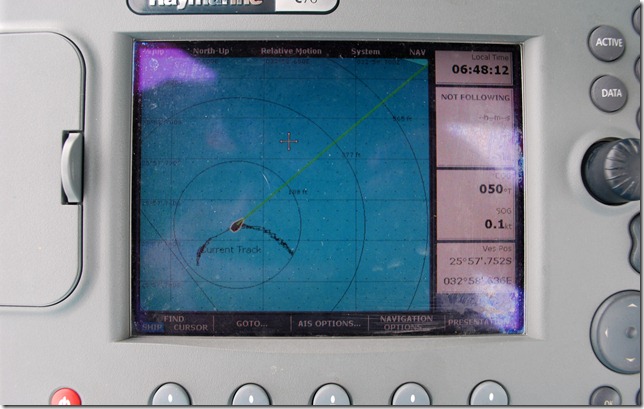 The semi-circle shows how the boat shifted around according to the wind
The semi-circle shows how the boat shifted around according to the wind
The strong winds continued all day Wednesday. We hadn’t seen anything like it since we were in the Kermadecs and saw the solar panels dislodged and outboard flipped. The wind generators seemed like they were spinning out of control and at one point were putting 33 amps into the house bank, the most we’ve ever seen. For the most part, the motion on the boat wasn’t too bad, but when high tide rolled around again and we were sitting perpendicular to the swell, we were picked up and slammed down by steep waves — a pretty wild experience considering we were at anchor! I’m just glad we weren’t bashing into them out at sea. All that time spent motoring in light winds on the way here really paid off.
Today (Thursday) is completely different. The wind has died down, and the forecast shows a brief weather window that should allow us to get to Richard’s Bay and maybe even Durban before the next buster is due to arrive on Sunday night. We’re going to give the seas a chance to die down a bit and probably set sail first thing in the morning.
We’ve been passing the time here at anchor by playing cards and watching movies. The southerly winds brought us a break from the heat, and in fact it feels a bit like fall. I can imagine that it must be like this back home (probably a bit colder) where everyone is gathered to celebrate Thanksgiving. Dallas and I are both fond of this holiday and wish we were home to enjoy it. We had talked about sharing some turkey and pumpkin pie with our American friends on S/V Bahati, but it looks like we are going to have to wait a while as they are already heading south from Durban. For now it’s just us. In the absence of a nearby grocery store, I’m having a hard time thinking of something special to make to mark the occasion, but I think some homemade bread will suffice.
For a brief time, we had a pet. Toward the end of the last passage we had a small, black seabird on board that was not at all shy. It began by resting out on the bimini but soon found its way inside and seemed to prefer hanging out with us, sheltered from the wind. Having it fly over and graze my head a couple of times led me to shriek in a stereotypically female way. Then it disappeared for a day or two, so I was pretty surprised to find it resting on the fan over my head when I woke up one morning. Unfortunately, I shrieked again yesterday when I pulled a pot from a top shelf in the galley and found it lying lifeless against the wall. I’m guessing that it got hold of a tablet used to kill roaches. R.I.P. little boat bird.
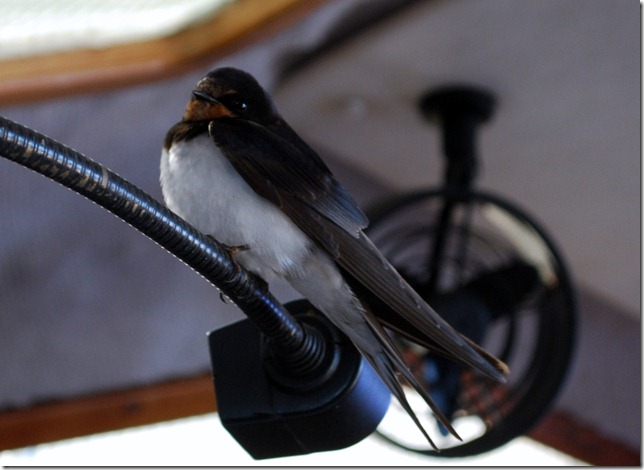 L.B.B. (Little Boat Bird) hanging out on the nav-desk light
L.B.B. (Little Boat Bird) hanging out on the nav-desk light
The only other company that we’ve had here at anchor was a few dolphins that swam around the boat yesterday. If only it were a little warmer, I would have been swimming with them for sure. We’ve been out of the tropics for less than a week, and I’m already missing the heat! Not really. This is a welcome change, and there should be a nice blend of warm and cool days on the east coast of South Africa, depending on the winds. When it’s warm, I’m planning to soak up a bit of sun on Durban’s beaches.
With a population of 3.5 million, Durban is South Africa’s 3rd largest city. We haven’t been anywhere like that for quite a while. It will probably be a bit of culture shock after two months of minimal contact with other people, but I venture to say that I’m ready for it!
Lat: 25 28.947′ S
Lon: 33 46.086′ E
This five day weather window has been without contrary winds, but the winds we have had have generally been pretty light. If we’d taken what the winds gave us, we’d be anchoring in Inhambane, two weather windows and probably two weeks away from South Africa. Instead, we’ve made liberal use of the D-Sail (diesel engines) to motor and motor-sail our way south. At this point, we’re set to reach Inhaca (in-YOK-uh) Island, near the Mozambique capital Maputo, just after sunset tonight, right before strong southerlies begin blowing. We were hoping to find a helpful current along the Mozambique coast once we reached the Bazaruto Archipelago, but if anything we seemed to have a bit of a counter current. When we finally sailed closer to the coast to “turn the corner” toward Inhaca and reached depths of 600 ft or so we found a southbound current of 0.5-1.0 knot or so that has stayed with us until now, and it seems to be turning south as we make our way farther west. With the light and variable winds, sail changes happen several times a day, with the main going up and down, the jib in and out, and yesterday the spinnaker even made an appearance for a few hours.
Most mornings have started with several squalls and light, cool westerly breezes off the land. Both dissipate about the time Lauren gets up, leading me to joke with her that the sun here waits for her to get up. We’ve enjoyed starting the day with fresh mangos and pineapple from Quelimane and since we reached Bazaruto, where we’ve sailed closer to the coast, seeing dolphins has been at least a once daily occurrence. They’ve been playful as usual, but yesterday’s batch were a little odd. They were smaller than the dolphins we’re used to seeing and instead of fully clearing the water in graceful arcs or leaps, they just jumped out sort of lazily until all of their body except the tail was nearly vertical and out of the water and then fell back onto the surface, landing on their sides with a flop. It looked more like the flops whales make than what we’re used to seeing dolphins do.
The days have been a mixed bag of overcast and temperate with enough wind to sail or clear and hot with very light winds. With such light winds, the wind-driven waves are almost nothing but the sea has never been flat. A slow, rolling, and sometimes large swell from the southwest serves as a reminder that that are some big winds over the horizon in the Southern Ocean with no buffering land mass between us.
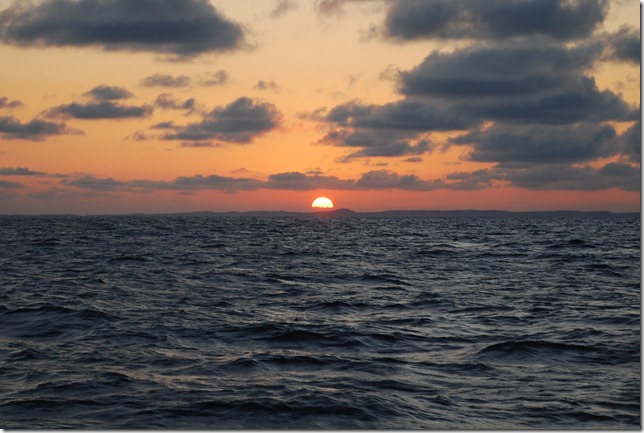 Sun setting over the Mozambique coast as we sail south close to shore
Sun setting over the Mozambique coast as we sail south close to shore
We’re nearing the end of a stretch where we’ve covered 8000 nm between Cairns, Australia and South Africa in 4 months, and we’re definitely looking forward to only having to cover 700-800 miles of South African coast in the next two months. Even though it’s the most dangerous area we’ll have to sail in from a weather perspective, we have the time to pick good weather windows and enjoy plenty of time ashore in an interesting place.
With just the two of us aboard, we’ve had a lot of time to reflect on the trip and how it has impacted us as a couple. Living in such close proximity to others when there were 4-6 of us, dealing with the needs of the boat, trip, and crew on a daily basis, and then sailing 8000 miles in 4 months with only infrequent contact with other people definitely puts some strain on a relationship in a way that most lifestyles don’t. On the other hand, we’ve enjoyed some incredible experiences together, done something that few people have the opportunity to do, and had the time for days filled with conversations and reflection. From what we’ve observed, it does seem like sailing at this pace is a bit easier for couples who have been together longer and have a better idea of who their partner is and how they relate to each other than it is for newer couples still learning about each other and their relationship and finding that they’re getting an opportunity to do that in a much more intimate and sometimes intense setting than they could ever imagine.
I remember the first circumnavigation that I followed online in the mid 90’s. It was a middle-aged but relatively new couple from Houston sailing a small, traditional boat via the Panama and Suez canals on a 2 year itinerary. Somewhere in Asia, the man wrote on the website that his partner had left for a stint back in the states and he didn’t know when or if she would return. If I remember right, she returned somewhere near Singapore or Thailand. I remember seeing the boat back in Houston after their return and being surprised by its small size, cluttered decks, and the broker’s comment that after 2 years at sea the boat stank. It definitely put some reality alongside the glossy cruising magazines.
In New Zealand, I spent a fair amount of time with Jimmy Cornell’s “World Cruising Routes”, working out on a piece of paper the distances, passage times, and optimal months for covering the distance between New Zealand and South Africa. The itinerary I worked out on it has been been our guide since then and the last line (Nov Madagascar to SA (~1500 nm)) is becoming obsolete more or less on schedule. It’s really amazing to take that piece of paper from inside the cover of the book and to look at it now. Something that seemed so daunting and unimaginable just 6 months ago is now nearly complete. Today I started another piece of paper for the Atlantic — South Africa to Florida. The South Atlantic should be a much friendlier bit of sailing and after crossing two oceans, the third doesn’t seem quite as daunting. The distance from the BVI to Florida, about 1100 nm, used to seem huge, but now it’s going to feel like we’re right next door to the Florida coast that we sailed from Amelia Island down to Key West before setting sail for Panama 19 months ago.
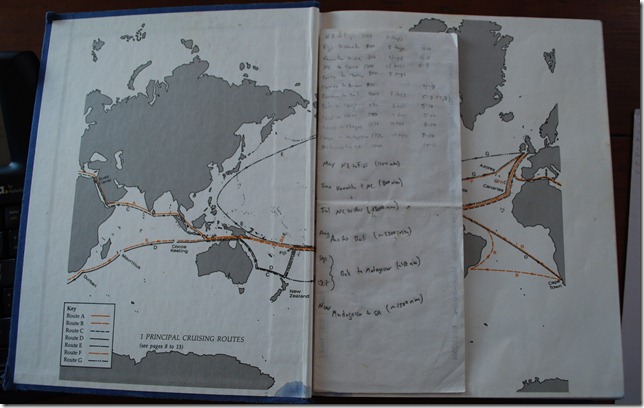 Inside cover of Cornell’s “World Cruising Routes” with the itinerary I originally worked out in New Zealand
Inside cover of Cornell’s “World Cruising Routes” with the itinerary I originally worked out in New Zealand
Lat: 20 25.402′ S
Long: 36 00.475′ E
Quelimane certainly was an experience, and looking back, it seems to be one of those times on the trip (like when I started the bottom job in N.Z.) that we got by with a little help from our friends. Although we spent most of our time on the boat, each time we ventured out into the city (usually accompanied by Garth), we felt more comfortable with our surroundings and the language and a little more savvy. And as usual, the negatives (e.g., getting charged 50% more the second day I went to buy bread from the street vendor) were easier to swallow with a spoonful of humor.
We motored back out of the river around 4 p.m., and most of the fisherman had returned to their villages with the day’s catch. We could see hundreds of people milling about the villages attending to their afternoon chores. Meanwhile at least 50 children were by the water’s edge taking turns jumping off of the wharf. We threw a couple of soccer balls in their direction, which seemed to be a big hit.
After a very windy night at anchor at the mouth of the river, we weighed anchor around 6:00 the next morning in very calm winds. We motored out of the partially marked channel with care as the channel itself is only 10-20′ deep and surrounded on both sides by sand bars and breaking waves. By nightfall the wind had picked up and from the ESE, and it carried us southward through the night. Today it has moved farther south, but at the moment we are sailing close-hauled at 7 knots in calm seas with the main and jib. Not too shabby! So far we (or more accurately, Dallas) have been able to find opportune weather windows for getting farther south, thereby avoiding the southerly busters that are known to produce large, steep seas here in the Mozambique Channel. We should be able to ride this one out for 2-3 more days which will get us to Inhambane or even Maputo, the capital of Mozambique. Once in Maputo we will be able to breathe a little easier knowing that we are out of the cyclone zone, and we’ll be only a hop-skip-and-jump from Richard’s Bay, South Africa! There is a game park near there that looks quite interesting…


